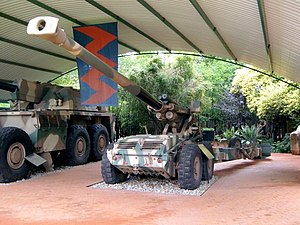G5 howitzer
| G5 155 mm Howitzer | |
|---|---|

G5 on display
|
|
| Type | Howitzer |
| Place of origin | South Africa |
| Service history | |
| In service | 1983 – present |
| Used by | Operators |
| Wars |
South African Border War Iran–Iraq War Gulf War |
| Production history | |
| Designer | Lyttelton Engineering Works |
| Designed | 1976–1983 |
| Manufacturer | Denel Land Systems |
| Produced | 1982 – present |
| Specifications | |
| Weight | 13,750 kg (30,314 lbs) |
| Length | 9.5 m (31 ft 2 in) |
| Barrel length | 6.975 m (22 ft 11 in) L/45 |
| Width | 3.3 m (10 ft 10 in) |
| Height | 2.1 m (6 ft 11 in) |
| Crew | 8 soldiers |
|
|
|
| Shell | high explosive |
| Breech | Semi-automatic interrupted screw |
| Carriage | split trail |
| Elevation | -3° to +75° |
| Traverse | Up to 15°: 82° Above 15°: 65° |
| Rate of fire | 3 rounds/minute |
| Muzzle velocity | 897 m/s (2,943 ft/s) |
| Maximum firing range | Standard: 30 km (19 mi) Base bleed: 39 km (24 mi) VLAP: 50 km (31 mi) |
| Feed system | Breech-loaded |
The G5 is a South African towed howitzer of 155 mm calibre designed and developed in South Africa by Denel Land Systems. The G5 design was based on the Canadian GC-45 155mm gun which was highly modified to suit southern African conditions.
During the Angolan Bush War, the South African Defence Force found itself at a disadvantage when facing opponents equipped with long-range Soviet Katyusha rocket launchers, which outranged South Africa's World War II-era 5.5-inch howitzers by a considerable margin. This led to the issue of a staff requirement for a new artillery system as well as ammunition systems, gun tractor, fire control equipment and a fire control computer system.
From 1963, South Africa had been placed under a United Nations sponsored anti-apartheid arms embargo that led to the creation of the indigenous Armscor military-industrial company to circumvent the arms embargo and to produce weapons systems uniquely tailored to South Africa's needs. Armscor responded to the staff requirement and commenced development in 1976. A number of existing designs were evaluated and examples procured in contravention of the arms embargo. As an interim weapon system to act as a stop-gap during the indigenous production process, a number of Soltam 155mm M-71 gun-howitzers were procured from Israel and entered service as the G4 howitzer.
The Canadian GC-45 was selected as the baseline howitzer from which to commence indigenous development. Armscor procured barrels, 30,000 rounds and design specifications for the GC-45 from Gerald Bull. One of the GC-45 test pieces was mounted on a US 155mm M59 carriage – and a further six GC-45s had changes made to internal ballistics, barrel construction and carriage and cradle fixtures, to become the prototype models eventually leading to the G5. These GC-45s had been developed by SRC International of Belgium, a joint venture between Gerald Bull's Space Research Corporation of Canada and PRB of Belgium. Further changes included the addition of a small APU to allow the gun to dig itself in and move short distances at up to 16 kilometres per hour (9.9 mph), as well as the addition of an advanced muzzle brake. The G5 became operational in 1983.
...
Wikipedia
